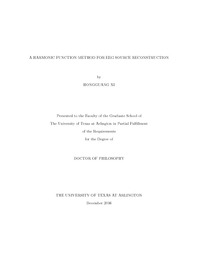
ATTENTION: The works hosted here are being migrated to a new repository that will consolidate resources, improve discoverability, and better show UTA's research impact on the global community. We will update authors as the migration progresses. Please see MavMatrix for more information.
Show simple item record
| dc.contributor.advisor | Su, Jianzhong | |
| dc.creator | Xi, Hongguang | |
| dc.date.accessioned | 2017-02-14T16:47:40Z | |
| dc.date.available | 2017-02-14T16:47:40Z | |
| dc.date.created | 2016-12 | |
| dc.date.issued | 2016-12-19 | |
| dc.date.submitted | December 2016 | |
| dc.identifier.uri | http://hdl.handle.net/10106/26444 | |
| dc.description.abstract | Neuronal activities generate the electrical current in the brain, and further result in the potential changes over the scalp. Electroencephalography (EEG) is a
technique used to record the potential changes on the scalp.
Even though fMRI, PET, MEG and other brain-imaging tools are widely used in brain research, they are limited by low spatial/temporal resolution, cost, mobility and suitability for long-term monitoring. In contrast, EEG signals have been successfully used to obtain useful diagnostic information (neural oscillations and response times) in clinical contexts. Further, they present the advantage to be highly portable, inexpensive, and can be acquired at the bedside or in real-life environments with a high temporal resolution.
In this dissertation we study a harmonic function method for dipolar source reconstruction, and apply the method to the real pain data. We first propose a new error estimate that is different from an earlier result of Chafik et al. and we provide a rigorous proof of the estimate. We then validate our method in computer-simulated data and study its numerical stability in different noise levels. Finally, we apply the method to EEG data acquired in pain experiments. Our result shows that when the hand is in the cold water there are strong activities near the prefrontal cortex and the anterior cingulate cortex, which is consistent with the known knowledge in neuroscience.
Though the harmonic function method is affected by the noise level, its simplicity and beauty make it a promising method for further development in EEG source reconstruction. | |
| dc.format.mimetype | application/pdf | |
| dc.language.iso | en_US | |
| dc.subject | Harmonic function method | |
| dc.subject | EEG source reconstruction | |
| dc.title | A Harmonic Function Method for EEG Source Reconstruction | |
| dc.type | Thesis | |
| dc.degree.department | Mathematics | |
| dc.degree.name | Doctor of Philosophy in Mathematics | |
| dc.date.updated | 2017-02-14T16:48:43Z | |
| thesis.degree.department | Mathematics | |
| thesis.degree.grantor | The University of Texas at Arlington | |
| thesis.degree.level | Doctoral | |
| thesis.degree.name | Doctor of Philosophy in Mathematics | |
| dc.type.material | text | |
Files in this item
- Name:
- XI-DISSERTATION-2016.pdf
- Size:
- 573.6Kb
- Format:
- PDF
This item appears in the following Collection(s)
Show simple item record


